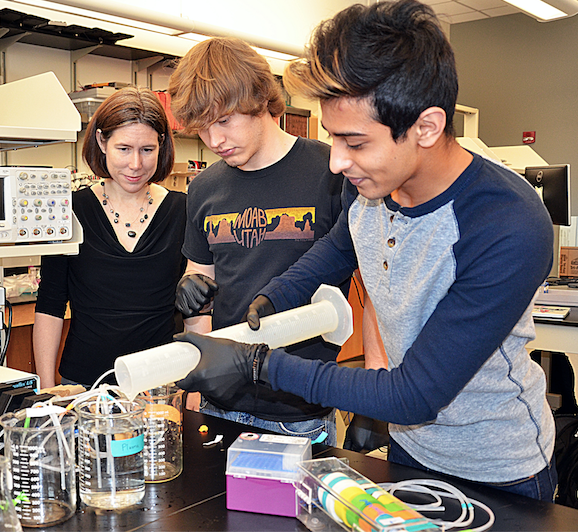"Flipped" Lab Course Advances Student Success
 By now you've heard: The "flipped" classroom reverses the traditional learning experience. Students access lectures online, where they absorb concepts on their own and at their own pace. During class time, teachers work directly with students on building skills in the subject matter.
By now you've heard: The "flipped" classroom reverses the traditional learning experience. Students access lectures online, where they absorb concepts on their own and at their own pace. During class time, teachers work directly with students on building skills in the subject matter.
Recent research in STEM pedagogy, including a three-year study of flipped chemistry courses at Purdue, concludes that student-centered approaches are more effective than straight lectures at conveying complex material.
What “flipped”?
Tamara Kinzer-Ursem, assistant professor of biomedical engineering, is leading the effort to improve the junior-level Biotransport Laboratory course, which focuses on experimental design, computational modeling and statistical analysis. The lab introduces three distinct, open-ended modules covering the delivery of nutrients to tissues, drug distribution throughout the body and preservation of cells in a deep-freeze state.
Traditionally, lab sections were supplemented by a stand-alone lecture. There was a very high student-to-instructor ratio and a poor correlation between lecture and lab components.
 “The lecture hall, with 80-some students in an auditorium, is not the right environment to get students engaged,” Kinzer-Ursem says.
“The lecture hall, with 80-some students in an auditorium, is not the right environment to get students engaged,” Kinzer-Ursem says.
Now the lecture material is available online, there is no stand-alone lecture and instructors use a portion of the lab time for problem-solving activities. “Our course is a good example of inquiry-based learning,” she says.
The first part of each module is spent examining sample problems, the types of problems they’ll be assigned to solve in the lab. “It’s much more interactive than a lecture,” Kinzer-Ursem says. “Covering sample problems reinforces both the lecture and their lab work.”
From the beginning, Kinzer-Ursem and her team knew that flipping the course would require additional time from instructors, who now provide problem-solving activities four times a week at the start of each lab section — instead of a single lecture.
Still, the smaller class size is more conducive to covering content and has increased student engagement with the material.
“In the lecture hall, it was difficult to get students to volunteer to answer questions or to work together,” Kinzer-Ursem says. “But in the lab, students sit with their team, working sample problems, and the instructor is free to move about the class, answering questions and also getting the students to volunteer answers.”
The flipped structure also makes it more natural for students and instructors to carry on discussions after the “lecture” portion of the lab is completed — tightening connections between lecture and lab materials.
Measuring success
Faculty measured the success of the restructured Biotransport Lab course by several criteria:
- The ratio of students to instructors was dramatically decreased by 73.4 percent.
- The mandatory in-class time was reduced from 4 to 3 hours per week.
- Student use of office hours and out-of-class time for lab work increased by 33 percent.
- Student satisfaction was evident through midterm and end-of-semester course evaluations.
Additionally, the new structure improved students’ average grades. Since the format changes began in 2011, students’ grasp of the material has improved steadily.
One unexpected positive outcome of the new format is an increase in the time that students work together with their team outside of normally scheduled lab hours.
Knowledge transfer
Work in the Biotransport Lab ingrains deep skills that benefit students in their engineering careers. For instance, experiences in the Biotransport Lab have improved students’ success in the senior capstone design class. For that course, students identify a market need and develop a product. “Our course functions as a precursor,” Kinzer-Ursem says. “It gets them in the mode of applying statistical analysis and rigor to their senior project.”
Student Daniel Romano says the Biotransport Lab prepared him to address high-level biomedical problems with readily available materials. “The Biotransport Lab taught us how to improvise,” he says.
Instead of walking through rote, line-by-line lab protocols, students learned how to investigate problems. Building upon earlier lab courses that include an independent design project, students in the Biotransport Lab are entirely free to choose how their team investigates the lab’s three modules. “Each lab course encouraged us to be more independent than the last,” Romano says.
In this year’s senior design course, Romano and his teammates won first place in the Weldon School’s design competition for their design of a “smart pill” that aids in diagnosing tuberculosis in South African children. The team’s design also earned a chance to compete nationally in the Rice 360° Institute’s Global Health Technologies Design Competition this spring.
Professor Kinzer-Ursem is pleased with her students’ enthusiasm and with the transformation of the Biotransport Lab course. “The students really step up to the challenge and design innovative solutions to the open-ended problems we give them,” she says.
Kinzer-Ursem’s next goal is to increase student engagement with the online lectures by incorporating multimedia elements and by aligning the mathematical and theoretical concepts more closely with laboratory activities.
Photos: Tamara Kinzer-Ursem with students in the Biotransport Laboratory.

